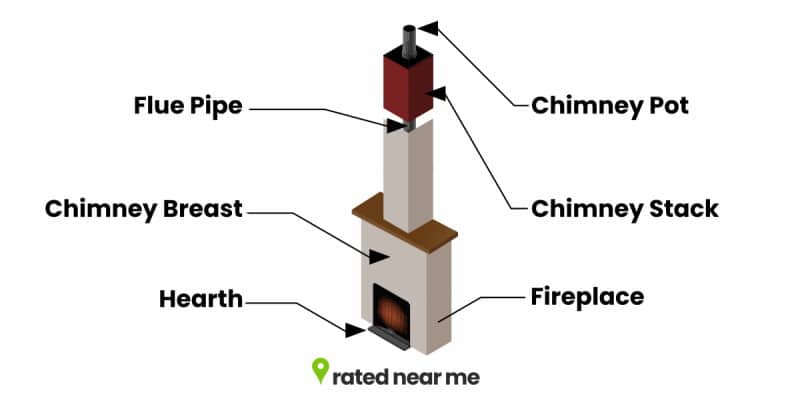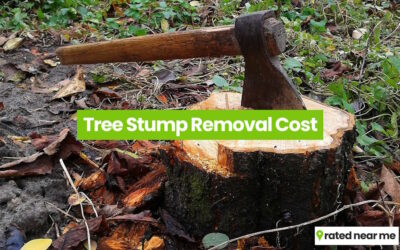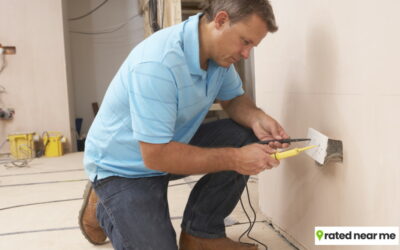There are many reasons why you might want to remove a chimney. This article will outline the costs of removing a chimney breast.
However, it is a major task that a competent building contractor should handle for you. We would not advise anyone to try to remove a chimney breast themselves without the proper qualifications and experience.
What price can you expect to pay to remove a chimney breast?
Estimates can be anywhere from £1,000 to £3,800 to remove a chimney breast by a professional. The final cost will depend on a few factors which we have covered in this guide.
What is a chimney breast?
The chimney breast is only a tiny part of the overall chimney structure. The removal process will most likely start in the living room – where the majority of chimneys are located. However, it may extend into the upper floor and loft, depending on the size of the house.
A chimney breast is a section of a chimney that protrudes from a wall to make room for a fireplace.
The brickwork rises upwards on the ground floor of the building. It contains a flue that transports smoke out of the building through a chimney stack. Chimney jambs are similar to fireplace jambs. They protrude from the wall on each side of the fireplace in order to support the chimney breast.

What is chimney breast used for?
A chimney breast is a critical component in dispersing heat throughout the room structure.
A chimneys heyday was back when a coal (or solid fuel) fire was the primary source of heat for a home. The introduction of central heating saw the demise of coal fires, so much so, people now think of chimney breasts as an inconvenience.
The Chimney Stack
As you can see from the image of the outside of a chimney, the chimney stack starts in the loft and exits through the roof. The chimney pot is the final element which is secured to the top of the stack.
If you’re thinking of removing the breast of your chimney, make sure the construction above is strong enough to withstand the weight without the support of the chimney breast. Be very careful!.
The Cost, Options And Time Related To Removing A Chimney Breast
We have included details for each part of the removal process along with costs for you:
| Job Description | Details Of The Job | How long would it take? | Average Cost |
| Remove chimney stack | Chimney stack removal, close up the cavity, then make repairs to the roof. | One day for two qualified roofers | £1,600 |
| Remove chimney breast without the stack | Install gallow brackets In the loft. Install a concrete hearth to make sure the floor is level. Install or re-fix skirting boards. Repair the ceiling if necessary. Re-plaster the room(s) if necessary. The chimney breast will be retained on the first floor. | At least five days for two qualified workers. Cost will increase if plastering and decorating is required. | £2,300 |
| Remove the chimney breast on the ground floor and install additional support on the first floor (half-detached property) | Install gallow brackets In the loft. Install a concrete hearth to make sure the floor is level. Install or re-fix skirting boards. Repair the ceiling if necessary. Re-plaster the room(s) if necessary. The chimney breast will be retained on the first floor. | At least four days for two qualified workers. Cost will increase if plastering and decorating is required. | £1,800 |
| Removal of chimney breast on the ground floor of a semi-detached three-bed house | Install gallow brackets In the loft. Install a concrete hearth to make sure the floor is level. Install or re-fix skirting boards. Repair the ceiling if necessary. Re-plaster the room(s) if necessary. | At least three days for two qualified workers. Cost will increase if plastering and decorating is required. | £1,500 |
Average Cost Of Removing A Chimney Breast
Keep in mind that each chimney project is unique.
The cost of removing a chimney breast varies depending on the property, but the average price is around £1,500. Contacting several local builders is the simplest way to receive quotes which you can compare.
Factors Which Affect The Price
Hearth removal
There are often special tools involved in the removal of a hearth, like using a demolition hammer. Professionals should have this type of equipment. If you were to do it yourself, the cost may increase as you would have to buy or rent the tools.
Ground floor only
They may also have to install skirting boards to fill the void around the wall. It could also require repairs to the ceiling which will involve plastering and painting of the room. Depending on the intricacy of the entire project, it will add more time and as a result, it may affect the price.
Bedroom only
If you are looking to remove the chimney breast just from one place, such as a bedroom, it will probably be cheaper than removing the entire chimney.
Remove chimney breast but leave the stack in place
Partially removing the chimney and leaving the stack in place should save you around £1,000.
Remove chimney stack only
Removing only the chimney stack usually costs between £1,000 – £2,000 (ex VAT).
Remove entire chimney
Depending on the size of your property, the price will vary. For example, removing the entire chimney in a two-story property will cost between £2,800 – £3,800 ex VAT.
Whereas, removing an entire chimney in a bungalow will be cheaper. Usually, the bigger your chimney breast is, the more it costs to remove it.
Hiring & erecting scaffolding
Contractors may need to hire and erect scaffolding for health and safety reasons, and to support the chimney as it is dismantled. Scaffolding hire is not cheap, so its best to get multiple quotes from scaffolding hire companies.
Rubble removal
Most building companies include the cost to remove rubble in their quotes, so make sure they do. If they don’t include this cost for rubble removal – it will increase the total price of the project.
Labour costs and timescales
The average time it takes to remove a chimney breast is approximately 2 – 5 days. If you want your chimney to be removed quicker, you will need to hire more people and this will affect the price.
Cost of hiring a specialist to remove asbestos (if needed)
Dealing with asbestos is serious, and can be dangerous to your health. It is often found in older properties throughout the UK. Hiring an asbestos specialist to take care of it will cost more, but for the sake of your health – it is definitely the smart thing to do!
Initial Assessment For Chimney Removal
Why remove the chimney breast?
If the chimney is no longer needed in your house, it’s worth considering “if it’s still worth keeping on your roof too”. If your fireplace has already been sealed off and is not in use, the chimney stack on your roof might be a liability.
As it is exposed to the weather elements, it may cost you money in future repairs for something that you don’t use.
Collapsed chimney breast
One of the main reasons to remove your chimney breast is because it is dangerous and could collapse. If there is signs that the support of the chimney stack and chimney breast have been weakened, they could collapse at any time – which is definitely not something you want to happen.
Cracking mortar
Masonry may contract and expand over time to allow small degrees of movement. Significant changes and movements typically result in cracks in the masonry. Cracks might occur in the mortar joints or in the bricks or blocks themselves.
An old chimney’s condition
If your chimney is old, and you have not been using it for a long time, its condition it likely to be getting worse over time. This is a good reason to remove the chimney breast and stack as soon as possible.
Damp
Damp spots on the chimney breast are typically signs of water damage or structural flaws. Brown or yellow stains on the walls and ceilings around the chimney may point to water damage from leaks. But check other areas of your house first as some of these leaks may be caused due to:
- Insufficient guttering
- Missing roof tiles
- Improper flashing details
- Absorbent brickwork
Asbestos
When servicing old fireplaces built using asbestos materials, there is a danger of exposure to asbestos. Asbestos fibres can cause mesothelioma, lung cancer, and other cancers when inhaled.
Will I need a structural engineer?
Yes, to put it succinctly.
When you remove a chimney breast, you are changing the structural construction of your home. It most likely that you’ll have to install additional support. A structural engineer can recommend the changes needed to your home’s structure.
They can also make your life easier by taking care of the calculations and drawing blueprints required by the building control officer.
Load-bearing structures
The removal of a chimney does not always impact the strength of the walls in every home. Even so, confirmation that this is the case will be required by your local building control office.
Keep in mind, that when only certain lower portions of the chimney are removed, anything above it like the stack and pots will need to be supported. Your engineer will need to provide specifications to support the remaining stack.
Is planning permission required to remove a chimney breast?
Internal modifications, such as removing a chimney breast, do not generally require planning approval because they as not considered additional development. However, modifying the structure of a listed building without getting the appropriate listed building approval is illegal – and you could find yourself in trouble.
UK Building Regulations For Removing A Chimney Breast
Firstly, you need to ensure the structural work complies with Part A of the Building Regulations in the UK. If you want to keep on the correct side of the building regulations, you should inform your local council to have a building control officer assigned to you.
You can also arrange for an authorised inspector to inspect the building before and afterwards.
Keeping in touch and working with an accredited inspector/building officer is the quickest way to receive sign-off and to get your documentation. You will get a completion certificate after the project is complete and this will prove that all the legal criteria was met.
Common Questions About Removing A Chimney Breast
How much time does it take to remove a chimney breast?
To completely remove a chimney breast can take anywhere from one to four days.
How dirty is it to take out a chimney breast?
Removing a chimney breast may be a dirty process due to the amount of dust generated. It’s advisable to clear out the space around the chimney as much as possible. It is also advisable to cover your your carpets and floors with a protective covering before beginning any work.
Does removing a chimney breast devalue a house?
While some people like the way chimney breasts look and believe it keeps the “character of a house”, the house won’t be less valuable if you remove it. The reason is, that they restrict the space of the room(s) too much and dictate where the furniture has to be placed.
Is it possible to remove a chimney stack and leave the flue?
Yes, but it’s tricky, our recommendation is to speak with a professional builder to ensure this is done correctly.
Can just half a chimney stack be removed?
If you share a chimney with an adjoined neighbour the entire shared stack may only be removed if both owners agree. If it is due to a fault, the cost will usually be split between both parties. If it is done as part of improvement work on one property, the owner who benefits from those improvements will usually bear the expense. In any event, it’s best is to notify your neighbour to let them know that you are going to do some work on the chimney. They can ensure that they protect the contents of their rooms from dust.
Is it possible to remove a chimney breast without removing the stack?
It is feasible to remove only the chimney breast rather than the complete chimney. This is a good option if you want to regain the space occupied by the breast in a room.
Checklist For Hiring A Specialist To Remove A Chimney Breast
When it comes to hiring someone to remove your chimney breast, there are a few things to think about. The following checklist contains items that you should consider before hiring anyone:
- Make sure that you receive a written estimate/quote. This way, you know precisely how much you’ll have to pay once the chimney breast has been removed
- Request a cost breakdown of the various project items, so you can be sure that you’re getting a fair price for each component of the project
- Always get a receipt for any part payments that you make
- Ask what materials the contractor will use for the job. Using better quality materials at this stage may save money on repairs in the future as a result
- Check to see whether the contractor has any expertise removing chimney breasts
- Ask to speak to previous customers who the contractor has removed chimneys for
- Check that the contractor is aware of any relevant building codes that they must follow
- Check the contractor will use necessary safety equipment to keep them and you safe
- Ask for proof from the contractor that they are covered by insurance. In the event that they or your house are damaged during the course of the project, you will want to know you/they are covered for repairs
Get Several Free Chimney Removal Quotes
Always get at least three different quotations for the job.
This will allow you to compare the prices and to check that each building contractor is quoting the for the same items/elements of the project. This will enable you to plan what needs done and when better too.
It also gives you some piece of mind that you are not overpaying for the project.
Get Quotes From Trusted Builders In Your Area
Speak to recommended and “rated” contractors near you, it’s highly likely that the cost of removing a chimney breast will be less expensive from a local firm in your area – as companies that are further away from you might charge more to cover travelling time and expenses.
Final Words About Chimney Removal
The most common reason for removing a chimney breast is to repurpose a wall within a living room and to create more living space.
In the old days, the primary purpose of fires (and chimneys) was to heat the house, that’s why fireplaces and chimney breasts were located inside the main living space. Today, most homes use an alternative heating source such as gas central heating or electrical storage radiators which are more energy efficient.
Aside from using this extra space taken up by a chimney breast for something else, there are other reasons to get rid of the chimney breast. You may opt to get rid of the chimney breast because it may be a potential safety hazard – perhaps due to structural cracks or asbestos.
If this is the case, removing the chimney breast or the entire chimney is a safe option. This way, you reduce the chance of the chimney collapsing and causing damage to you or other parts of your home.
Featured images credit: Design photo created by freepik – www.freepik.com



